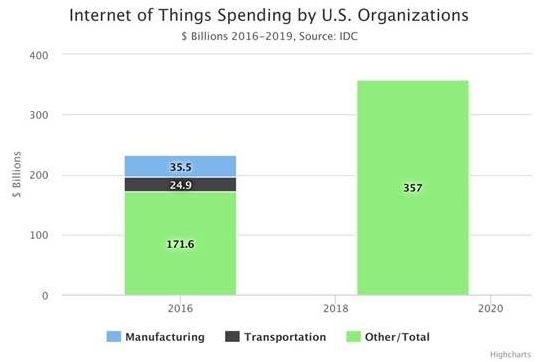Internet of Things Forecasts & Best Practices
In 2010, Ericsson’s former CEO Hans Vestburg presented his prediction on the Internet of Things to shareholders: The world will have 50 billion connected devices by 2020. Was his prediction on point? Not quite but more realistic than what IBM forecast in 2012: 1 trillion connected devices by 2015. Nevertheless, the current rate is somewhere between Gartner’s estimate of 6.4 billion, and global marketing intelligence firm International Data Corporation’s estimate of 9 billion - smartphones, tablets, and computers are excluded. Meanwhile, IHS also estimates 17.6 billion, including all such devices.
Hans Vestburg wasn’t the only one who shot for the stars with the potential for IoT growth. Dave Evans, who worked for Cisco at the time, stated the same prediction in a white paper. However, both of them re-set their expectations, and now Evans expects to see 30 billion connected devices by then, while Ericsson figures on 28 billion by 2021. Also, Gartner expects 20.8 billion by 2020, while the International Data Corporation (IDC) anticipates 28.1 billion. Both exclude smartphones, tablets, and computers, although a collaborative report from DHL and Cisco aggressively estimates 50 billion devices by 2020.
 “Such variation and fluidity of these numbers is typical of early estimates focused on nascent markets. The point, he suggests, is to think of the estimates as a general signal, rather than focus on the specific numbers,” says Vernon Turner, a Senior IoT Analyst at IDC. Given that the forecasts identify the huge potential of the market, he added: “I don't think we’ve seen this type of market size before, to be honest.”
“Such variation and fluidity of these numbers is typical of early estimates focused on nascent markets. The point, he suggests, is to think of the estimates as a general signal, rather than focus on the specific numbers,” says Vernon Turner, a Senior IoT Analyst at IDC. Given that the forecasts identify the huge potential of the market, he added: “I don't think we’ve seen this type of market size before, to be honest.”
If we look back at the late 1990s, the same sort of scenario played out with Bluetooth development, as every year analysts predicted we would see a significant increase in Bluetooth-enabled devices but every year the predictions failed until the early 2000s, when Bluetooth was finally adopted by leading cell-phone manufacturers. From there, the technology picked up speed. Who knows if the same inflection point with the Internet of Things will happen anytime soon. In fact, Joep van Beurden, CEO at CSR, a semiconductor company that produces wireless technologies, notes that the Internet of Things still hasn’t reached its tipping point: “I don’t think it has been overhyped by any means. I just think widespread adoption will happen later than we expected.”
Entrepreneurs and investors are dazzled by the onslaught of new IoT forecasts and jumping at the opportunity to execute their IoT projects with exciting use cases to create new value, while corporate giants are in a head-to-head competition to dominate the widely coveted Internet of Things (IoT) landscape. Today, eight companies with market capitalizations over $150 billion actively promote IoT solutions: Google, Microsoft, Amazon, General Electric, AT&T, Verizon, IBM, and Cisco.
In fact, according to IDC’s recent forecast, U.S. organizations will invest more than $232 billion in Internet of Things (IoT) hardware, software, services, and connectivity this year. And, IDC expects U.S. IoT revenue will experience a compound annual growth rate (CAGR) of 16.1% over the 2015-2019 forecast period, reaching more than $357 billion in 2019. While Manufacturing and Transportation will lead the U.S. in terms of overall IoT investments, the Insurance, Retail, and Healthcare industries will see IoT spending levels increasing by 135%, 101%, and 96% respectively, over the forecast period.

The UK government also recently announced it will spend an extra £45m on developing Internet of Things-enabled technology, doubling the funds currently available to UK technology firms working on everyday connected devices.
Businesses are looking to integrate IoT into their organizations and offerings, as it lowers operating costs, increases productivity, and gives organizations the opportunity tap into new markets. To do so, they even reinvent themselves in order to adapt to the IoT market. Cisco and Intel, for instance, announced massive layoffs in their traditional businesses to focus on IoT. Cisco said earlier this month that it would shed 5,500 staff as it "refocuses on IoT, security, next-generation data centers and cloud" services. Intel announced at last week's Intel Developers Forum that it would concentrate on IoT and virtual reality followed its decision in April to lay off 12,000 employees, most of them involved with Intel's historic (but slowing) personal computer activities.
The growth of IoT devices is virtually exploding. IDC predicts IoT to grow at a compound annual growth rate (CAGR) of more than 19% through 2020 while other connected devices will lag comparatively at only a 9.5% CAGR. A global Internet of Things report submitted by Technavio predicts an annual growth rate of more than 20%.
IoT technologies have already started to add new enhancements to safety and security along with greater efficiency and improved environmental sustainability. McKinsey Research predicts we’ll have 600 smart cities throughout the world by 2020 and they will be responsible for generating 60% of the world’s GDP by 2025. It means that smart cities that utilize sensors and actuators to wirelessly connect all of the services we associate with city living like lighting, traffic routing, heating, cooling, emergency response systems and so on, will no longer just be a scene from a science-fiction movie. Driverless cars that communicate with each other and traffic lights to prevent traffic jams and collisions are already innovated. Countries like the Netherlands and South Korea have been working on creating wireless networks entirely devoted to serving IoT devices with Low Power Wide Area Networks (LPWANs), although Bill Morelli, Senior Director, IT and Networking at IHS Markit, estimates 90% of communication devices are switched on, while perhaps only 50% of cars and accessories are ever connected. In addition, the city of Mississauga, Canada’s sixth largest municipality, uses the Cisco IoT System to deliver city-wide Wi-Fi, connect its transit systems, optimize buildings, and run an intelligent streetlight system – all managed through a single command and control center.
The penetration of IoT technologies at this level also means that millions of devices generating and sharing massive amounts of data will be analyzed and used to assess future patterns through predictive analytics. As a result, marketers can gain a great opportunity to measure, collect, and analyze an ever-increasing variety of behavioral statistics in order to have a deeper insight into everyday behaviors. As the shift turns from pilot projects to enterprise production, IT involvement is necessary for efficient management and security.
Speaking of marketing, significant changes must be made for IoT to reach enterprise grade and scale. For instance, voice-activated assistants like Amazon’s Alexa and Google Home will change the way consumers search for information. As users grow more accustomed to this way of search, keyword-based queries will consequently disappear. Eventually, marketers will adopt an optimization method to be found via IoT searches, rather than for click-through rates in search engines. On the bright side, personalization will be even more feasible due to a massive amount of data. Consumers will get even more relevant content and information out of search.
To put how the IoT system can improve services and products into perspective: Cisco worked with Harley-Davidson for the motor company to deploy plant-wide Ethernet architecture and digital signage, giving the motorcycle manufacturer flexibility across its supply chain. The new architecture also provides an expansive view of information across the organization and helps reduce plant downtime. Employees also reported an improved working culture.
“We now have greater manufacturing flexibility across the supply chain… and have experienced a substantial reduction in downtime. What used to take hours or days to triage and troubleshoot now takes seconds,” said David Gutshall Infrastructure Design Manager at Harley-Davidson Motor Company.
Another great example of IoT and big data working together is happening in Barcelona. The city offers smart parking meters that operate on city-wide wi-fi, giving residents real-time updates on where to park and allowing them to pay with their phone. Smart bus-stops provide passengers with real-time updates via touch-screen panels, and a city-wide sensor network informs workers and residents about temperature, air quality, noise level, and pedestrian traffic. To do so, Barcelona takes advantage of a big-data system on Microsoft Azure to process and analyze the myriad of data points it is receiving. The insights generated by the system enables the city to offer better public transportation, more efficient plans for events like the La Mercé Festival, and a better understanding of the impact of tourism.
IoT means easier access to more data and better insights but it also brings some formidable challenges. The sheer size and speed of the data can overwhelm the sturdiest network infrastructure. As a result, delays caused by bandwidth congestion or inefficiently routed data may create chaos in some cases. Ensuring the security of devices and the privacy of users shouldn’t be sacrificed either. Today, customers have higher expectations around speed and dependability than ever before. Technologies often grow in unexpected ways and at unexpected rates so if your organization is planning to invest in this space, you should at least know that a partial commitment to IoT isn’t enough. The network architecture must be considerably designed and capable of being upgraded to meet future needs.

Venus Tamturk
Venus is the Media Reporter for CMS-Connected, with one of her tasks to write thorough articles by creating the most up-to-date and engaging content using B2B digital marketing. She enjoys increasing brand equity and conversion through the strategic use of social media channels and integrated media marketing plans.